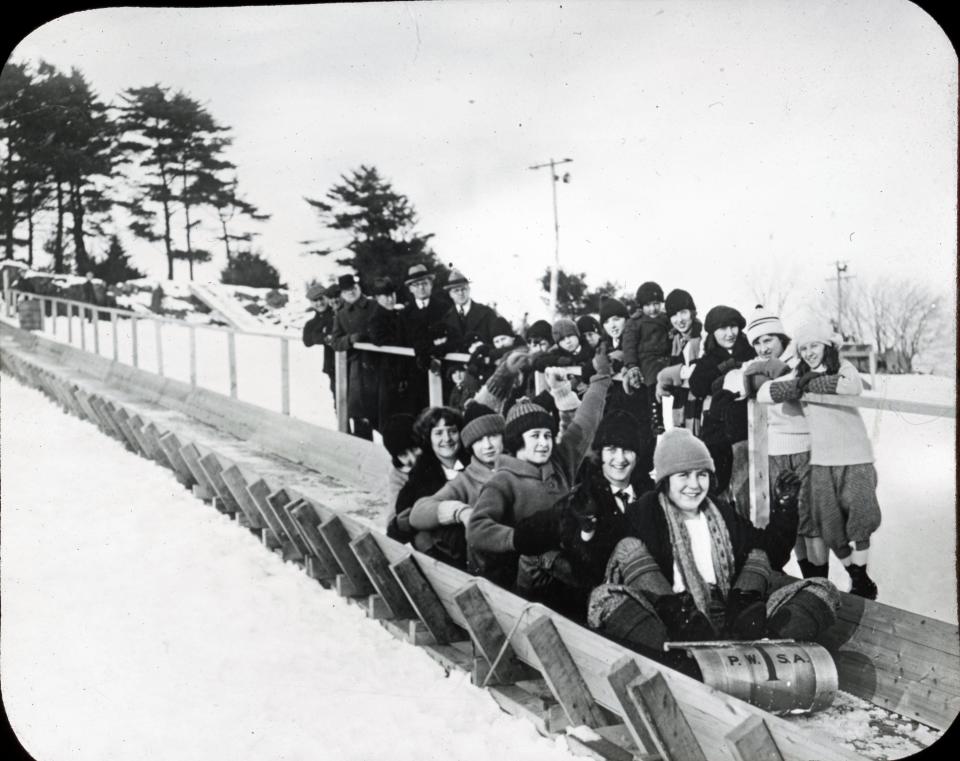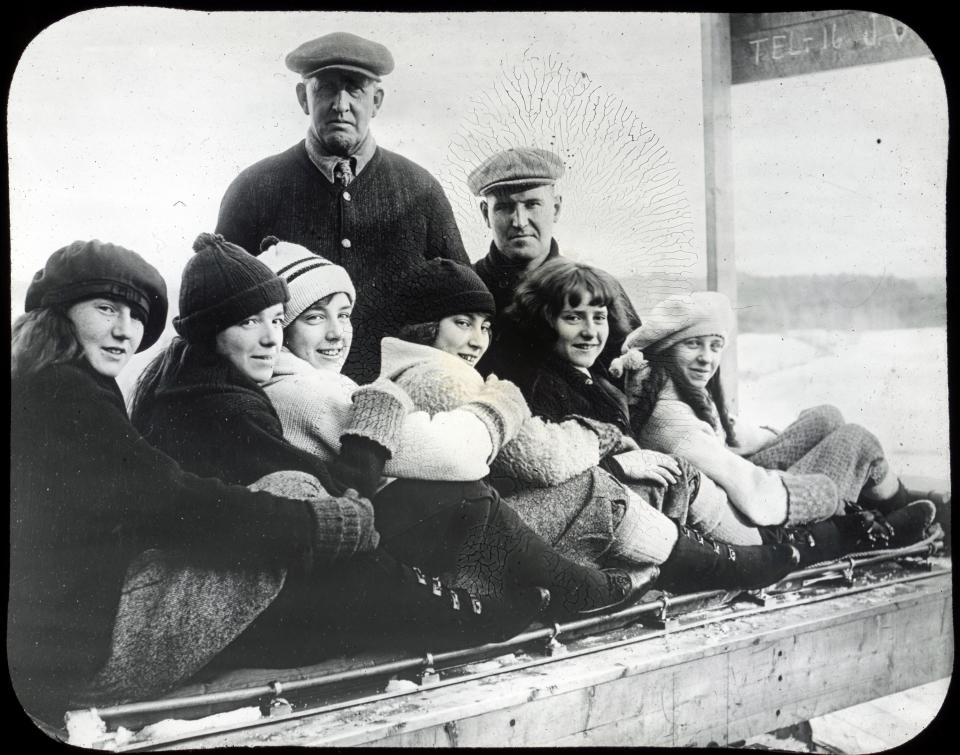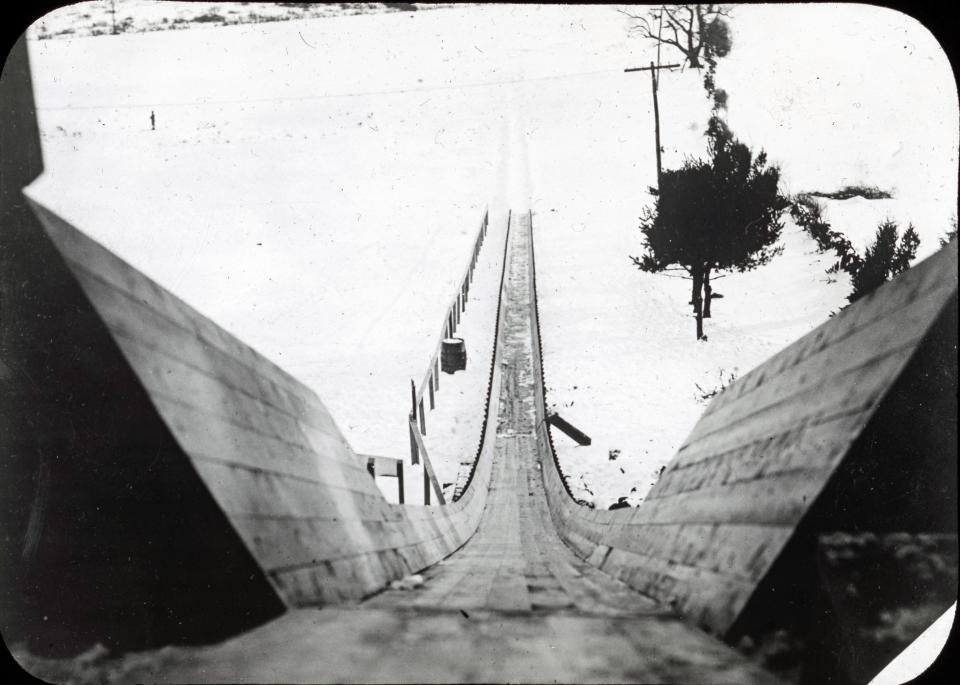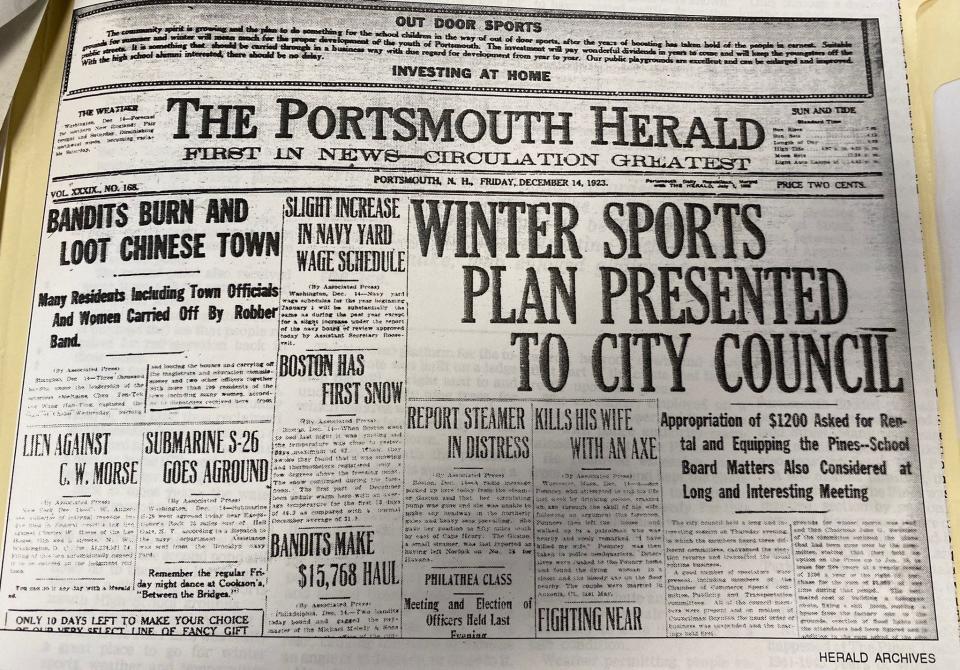The Pines: When Portsmouth enjoyed a winter sports hotspot a century ago
"GREAT CROWD AT PINES ON SUNDAY," the Portsmouth Herald's Page 1 story proclaimed on Feb. 11, 1924.
A big draw was a toboggan chute on the southern-sloping hillside off South Street. The chute was built by the Portsmouth Winter Sports Association and opened to the public on Feb. 2, 1924.

The chute "was iced during the forenoon and the toboggans take it at express train speed, giving everybody a thrill," the Portsmouth Herald reported. "It worked perfectly and at times the toboggans were being sent off the tilt table at the rate of four a minute."
The rest of the hill was being used for sledding, skating and skiing; there were two ski runs and three skate ponds.
"It is surprising how many of the little people are taking to skis and once they master them they are very graceful. At night the entire field was flooded with lights and it made a very animated picture, especially the toboggan chute," the Herald article said.
When Portsmouth boasted its own hill for sledding, skiing

Portsmouth Athenaeum photographic collections manager James Smith recently donated and catalogued several images showing tobogganers on the site, which now includes a senior living community known as The Pines at Edgewood Centre.
The Portsmouth Winter Sports Association began life as a Chamber of Commerce committee in December 1923. A president was elected — John G. Sweetser — and nine directors recruited to solicit private donations. Buttons were to be sold at $1 each to those who wished to take part in winter sports at The Pines. Toboggan rentals (50 cents an hour) would also help cover costs.
By Dec. 20, 1923, the association had leased land from Marcellus Marston. The Portsmouth City Council voted to contribute $250 to kick start the project.
Mayor Orel Dexter and city councilors were among the first to take slides down the chute, which was open from 10 a.m. to 10 p.m. Monday to Saturday and noon to 10 p.m. on Sundays.
"The association feels that there is much sentiment in this city for winter sports and that the merchants and public at large will support this project and put Portsmouth on the map during the winter months," the Portsmouth Herald wrote.
In 1999, William H. Brooke Jr. (1911-2007) recalled his hours at the site, just east of the grounds of modern-day Portsmouth High School.
Brooke compared the hillside to an amphitheater, kept clear of trees by local farmers who mowed and hayed to feed their livestock. The site was used for Portsmouth's 300th anniversary pageant in August 1923.
It was widely reported that on a clear day, Mount Washington could be seen from the top of the hill.
In his essay in the Portsmouth Herald, Brooke said there were two ponds — one at the top of the ridge and a second at the bottom of the hill.

"When frozen, these ponds afforded excellent places for skating," Brooke wrote. "The lower — or second — pond seemed to be the more popular of the two, attracting both young and old alike, who enjoyed gliding over the ice.
"Though many went to the second pond for general skating, there were the hockey players, too, enjoying their fast games chasing the puck."
Architect Wallace E. Dibble of Springfield, Massachusetts, designed the toboggan chute to deliver speeds of more than 40 mph.
Brooke wrote about how during the summer, youngsters would ride their bicycles down the chute. He tried it in his "coaster wagon," but had the good sense not to start at the top, which was 20 feet off the ground. Instead he coasted in the lower, flat part of the chute. Perhaps that caution is one of the reasons Brooke lived to be 95.
The Portsmouth Winter Sports Association was less cautious. It would go on to take out a five-year lease on The Pines property. By the winter of 1925, the Portsmouth Amateur Hockey League had formed, with five teams playing three nights a week.
'Tough sledding financially' leads to end of Pine Hill

But as Portsmouth historian Ray Brighton (1914-1997) observed in notes preserved in the Athenaeum archives, "it was tough sledding financially."
"Winter Sports Face Deficit," declared a Portsmouth Herald headline that Brighton (a longtime editor of the paper) included with his neatly typed notes for his 1973 history of Portsmouth, "They Came to Fish."
In a footnote for the book, Brighton mentions Charles W. Gray of Rye, who remembers "jumping 55 feet" in his college days at The Pines' ski jump.
The costs of getting The Pines ready for each season and maintaining the toboggan, ski runs and skating ponds were greater than expected. Income from rentals dropped as people brought their own toboggans to the hill.
When 1928 came, the directors of the Winter Sports Association decided not to renew the lease on the land.
For a few winters, the city flooded the ballfield between Parrott Avenue and Rockland Street, Brooke said.
"Many were eager to skate on this huge rink," he wrote.
He said the slopes of Langdon Park off South Street, Lincoln Avenue and Junkins Avenue became a popular sledding spot.
When the toboggan chute was dismantled at The Pines, Brooke said rumors flew that the chute would be reassembled in Langdon Park.
"This, however, was never done," he said.
The Portsmouth Athenaeum, 9 Market Square, is a nonprofit membership library and museum founded in 1817. The research library and Randall Gallery are open Tuesday through Saturday, 1 to 4 p.m. For more information, call 603-431-2538 or visit www.portsmouthathenaeum.org.
This article originally appeared on Portsmouth Herald: The Pines: Portsmouth NH winter sports hotspot a century ago

